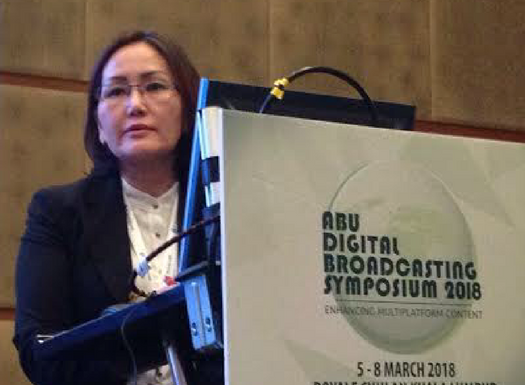As the Digital Broadcasting Symposium held in Kuala Lumpur this week draws to a close, Asia Radio Today takes a look back at its top ten moments, quotes and ‘takeaways’ from the event.
1. Speaking about the perennial appeal of live content Anklet Rangnekar, Head of Live Production at Ideal Systems Singapore, wins catchphrase of the conference: “content is king, relevance is King Kong.”
2. Joan Warner, CEO at Commercial Radio Australia and vocal advocate of radio reminded delegates about the uniqueness of radio when stacked up against new competitors online, including social media.
“In radio’s case, and it has happened in some countries, is they’ve forgotten what people value about radio is it’s live and local – you can talk to people, you can talk to your Prime Minister live on air if you want to, you can tweet, you can engage via social media.
“Traditional broadcasters have to remember what the key strengths are (of radio) and don’t be frightened by the future. But also don’t feel so threatened, as some people in traditional media seem to feel, because the billions of people listening to radio around the world are not going away any time soon.”
3. Abdul Hakim Amir, from Astro’s Content Development & Production Unit, on how broadcasters can utilise content that would otherwise not make it to air: broadcasters should be “repurposing, reusing, repackaging” content to reach wider audiences.
4. Ahmed Zaki, Group General Manager of Engineering at Media Prima Berhad summed up the frustrations and issues of lack of standardisation: “Standardisation of IP for broadcasting is very important,” he said. “It’s got an immediate and direct link back to the cost of our operations.
“We have to make sure all the manufacturers, the vendors work with equipment with the (latest SMPTE) standard. One of the major operating costs we are undergoing today is actually incompatibility. Incompatibility between equipment… it’s probably one of the biggest headaches that the broadcasters can go through.
“To standardise, to make sure that in future moving into IP all equipment must talk and must be able to be interfaced with each other is very, very crucial because it makes our costs low.”
5. Tegshgerel Oyuntogtokh, Director Mongolian’s MNB World helped delegates to understand Mongolia a little better. In her presentation she reflected on how broadcasters must “better understand its audiences, increase engagement and diversity, set new priorities and work to be the most trusted source of information.”
Oyuntogtokh also spoke about the need to reach younger audiences but admitted that “it’s one thing to talk about change and transformation, and it’s another thing to achieve it.”
6. Lars Peder Lundgren from Paneda shared some examples of advanced DAB+ and hybrid features, particularly focusing on the importance of interaction with listeners: “its getting more and more important,” said Waterson.
He shared the results of a test undertaken by a large commercial radio station in Italy, RTL 102.5. The station developed a Facebook application where listeners could can add likes and comments and these would be fed straight into DAB.
“So they had an allocated space, below the picture (on the DAB radio) where the data came from that (Facebook) application,” said Lundgren.
“They did this test for a number of reasons,” he said, “they wanted to know: do we get more listeners doing this? Do they stay tuned longer? Yes, they did. And most important – they didn’t change programs during commercial breaks.” The station got around a thousand new listeners every week during the test.
7. When asked about the impact India’s Digital Radio Mondiale (DRM) rollout would have on the rest of the world, Alexander Zink, Senior Business Development Manager at Fraunhofer noted that “whatever’s going on in India and the big members of ABU like Indonesia, that definitely has an impact on the rest of the world.
As the recommendation to digitise the FM band in India matures into a roll out, it gives the “starting point for the private broadcasters in the country to be on board. It also means that it will be able to see more support on the radio side, on the car industry side for digital radio being built in and in all the models.”
“Digitising the FM band in particular will give the opportunity for smartphone manufacturers to support digital radio there under the FM band natively with a simple firmware upgrade on the devices without requiring any additional chips.”
Zink talked about private broadcasters in India already getting excited about the possibilities of digital radio, and there will be “great reverberations from the whole Asia-Pacific region, where the big smartphone manufacturers are, and yes there is lots of impact on the whole region.”
8. Chulbum Kim from EBS-Korea shared E.MOT.ION, a radio broadcasting system they have developed that has helped them be more efficient in terms of workflow. “It’s reflecting the experience we have accumulated for forty years,” said Kim. “It’s very competitive in terms of cost when compared to the States or European countries. It’s well customised for the broadcasters.”
9. Andi Permadi, Head of New Media at Radio Republik Indonesia shared his secrets about interest and interaction for the content on their 99 stations. “Every time we have a campaign we create a twitter hashtag… I will tell them the program we have for tomorrow, the hashtag’s like ‘this’ and we have to tweet… the goal is to make it a trending topic.”
10. Thinking about the role of traditional terrestrial broadcasting in the new media landscape, particularly when it comes to providing information during disasters, Charles Sevior from DELL EMC said “we should never forget the ability of broadcasting to still reach a vast audience and the simplicity of the technology and the simplicity of the reception… we shouldn’t lose sight of the fact that both technologies continue to run in parallel.”

